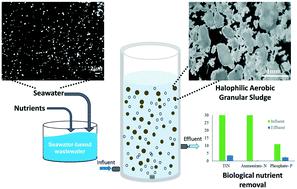当前位置:
X-MOL 学术
›
Environ. Sci.: Water Res. Technol.
›
论文详情
Our official English website, www.x-mol.net, welcomes your feedback! (Note: you will need to create a separate account there.)
Granulation of the autochthonous planktonic bacterial community of seawater for saline wastewater treatment
Environmental Science: Water Research & Technology ( IF 5 ) Pub Date : 2020-05-28 , DOI: 10.1039/d0ew00373e M. Sarvajith 1, 2, 3, 4, 5 , Y. V. Nancharaiah 1, 2, 3, 4, 5
Environmental Science: Water Research & Technology ( IF 5 ) Pub Date : 2020-05-28 , DOI: 10.1039/d0ew00373e M. Sarvajith 1, 2, 3, 4, 5 , Y. V. Nancharaiah 1, 2, 3, 4, 5
Affiliation

|
Aerobic granular sludge (AGS) process is a fast-growing sustainable biological treatment for wastewater. Activated sludge (AS) is the standard inoculum used for cultivating AGS, even for the treatment of saline wastewaters. However, the application of the allochthonous AS community for both developing halotolerant AGS and establishing biological nutrient removal (BNR) under saline conditions is a challenging task. To circumvent this problem, herein, the cultivation of AGS directly from the autochthonous planktonic bacterial community of seawater was investigated. For developing halophilic AGS, a sequencing batch reactor was operated by directly supplying nutrient-amended seawater without inoculum (i.e., AS or AGS). The approach described herein succeeded in rapidly granulating the planktonic bacteria of seawater and establishing BNR at a 34 ppt salinity. The ammonium and total nitrogen removals of 92–100% and 81–90% were observed during 22–100 days of start-up, respectively. Interestingly, nitrite accumulation was not observed under saline conditions. Phosphate removal progressively improved and stabilized at over 76% within 2 months of start-up. The phosphate removal profiles comprised of P release and uptake phases, which are typical to those of the enhanced biological phosphorus removal mechanism. The granulation of planktonic microbes involved distinct events such as the formation of micro-aggregates, macro-aggregates, and granules but not flocs. Granular growth was observed within few days, suggesting that the granulation of the autochthonous planktonic microbial community of seawater is a rapid phenomenon. The granules were dense (1.5 g ml−1) and compact (SVI5: 6 ml g−1) and had an excellent settling velocity (41.2 m h−1) on day 25. Moreover, 16S rRNA gene sequencing revealed that AGS had lesser bacterial diversity than the seawater microbiome due to the enrichment of α-proteobacteria. The removal of nitrogen and phosphorus was not significantly impacted at the lower salinities of 25 and 17 ppt. Furthermore, the halophilic AGS was able to achieve an efficient BNR and treatment of real seafood processing wastewater without acclimation. Thus, granulation of the autochthonous halophilic bacteria of seawater is a novel strategy for developing halophilic AGS and to achieve a high BNR under saline conditions.
中文翻译:

海水自生浮游细菌群落的造粒处理含盐废水
好氧颗粒污泥(AGS)工艺是一种快速发展的可持续废水生物处理方法。活性污泥(AS)是用于培养AGS(甚至用于处理含盐废水)的标准接种物。然而,将异源AS群落用于在盐条件下开发耐盐的AGS和建立生物营养去除(BNR)都是一项艰巨的任务。为了解决这个问题,本文研究了直接从海水的本地浮游细菌群落中培养AGS的方法。为了开发嗜盐AGS,通过不经接种直接提供营养成分改良的海水来操作测序间歇反应器(即,AS或AGS)。本文所述的方法成功地使海水中的浮游细菌成粒并在34 ppt的盐度下建立了BNR。在启动过程中22-100天分别观察到铵去除率和总氮去除率分别为92-100%和81-90%。有趣的是,在盐水条件下未观察到亚硝酸盐积累。在启动后的2个月内,磷酸盐去除率逐渐提高并稳定在76%以上。磷的去除曲线包括磷的释放和吸收阶段,这是增强型生物除磷机理的典型特征。浮游微生物的颗粒化涉及不同的事件,例如形成微聚集体,大聚集体和颗粒,但不形成絮凝体。几天内观察到颗粒状生长,这表明海水中的自生浮游微生物群落的造粒是一种快速现象。颗粒稠密(1.5克/毫升-1)和致密的(SVI 5:6 ml g -1),并且在第25天的沉降速度极佳(41.2 mh -1)。此外,16S rRNA基因测序表明AGS的细菌多样性低于海水微生物组,原因是α-变形杆菌的富集。在较低的盐度(25和17 ppt)下,氮和磷的去除不会受到显着影响。此外,嗜盐的AGS能够实现有效的BNR,并且可以在不适应环境的情况下处理真正的海鲜加工废水。因此,将海水的本地嗜盐细菌造粒是开发嗜盐AGS并在盐分条件下获得高BNR的新策略。
更新日期:2020-07-02
中文翻译:

海水自生浮游细菌群落的造粒处理含盐废水
好氧颗粒污泥(AGS)工艺是一种快速发展的可持续废水生物处理方法。活性污泥(AS)是用于培养AGS(甚至用于处理含盐废水)的标准接种物。然而,将异源AS群落用于在盐条件下开发耐盐的AGS和建立生物营养去除(BNR)都是一项艰巨的任务。为了解决这个问题,本文研究了直接从海水的本地浮游细菌群落中培养AGS的方法。为了开发嗜盐AGS,通过不经接种直接提供营养成分改良的海水来操作测序间歇反应器(即,AS或AGS)。本文所述的方法成功地使海水中的浮游细菌成粒并在34 ppt的盐度下建立了BNR。在启动过程中22-100天分别观察到铵去除率和总氮去除率分别为92-100%和81-90%。有趣的是,在盐水条件下未观察到亚硝酸盐积累。在启动后的2个月内,磷酸盐去除率逐渐提高并稳定在76%以上。磷的去除曲线包括磷的释放和吸收阶段,这是增强型生物除磷机理的典型特征。浮游微生物的颗粒化涉及不同的事件,例如形成微聚集体,大聚集体和颗粒,但不形成絮凝体。几天内观察到颗粒状生长,这表明海水中的自生浮游微生物群落的造粒是一种快速现象。颗粒稠密(1.5克/毫升-1)和致密的(SVI 5:6 ml g -1),并且在第25天的沉降速度极佳(41.2 mh -1)。此外,16S rRNA基因测序表明AGS的细菌多样性低于海水微生物组,原因是α-变形杆菌的富集。在较低的盐度(25和17 ppt)下,氮和磷的去除不会受到显着影响。此外,嗜盐的AGS能够实现有效的BNR,并且可以在不适应环境的情况下处理真正的海鲜加工废水。因此,将海水的本地嗜盐细菌造粒是开发嗜盐AGS并在盐分条件下获得高BNR的新策略。

























 京公网安备 11010802027423号
京公网安备 11010802027423号